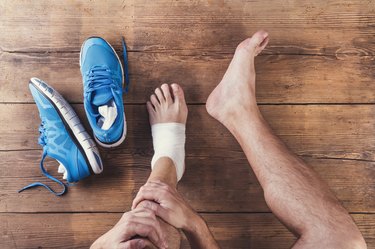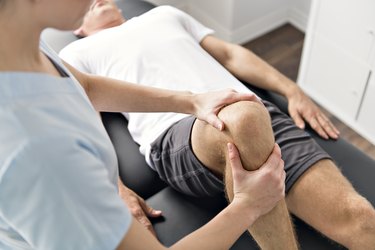
Almost nothing derails your workout routine faster than an exercise injury — whether it's a sprained ankle, pulled muscle or torn ligament. The good news is that this workout injury prevention guide will help decrease the risk of getting hurt during exercise.
Start with a solid warm-up before every workout and focus on range-of-motion and strengthening movements for all of your joints, especially those prone to injury (think: knees and ankles). And if you do find yourself dealing with runner's knee, a rotator cuff tear, back pain, shin splints or any other kind of workout injury, specific, gentle exercises and stretches can help you heal faster.
First, Prevent Workout Injuries Before They Occur

Warm Up Before You Work Out
One of the best ways to prevent workout injuries is by warming up beforehand. It's easy to overlook these first crucial five to 10 minutes, but they can save you from a world of hurt.
"When muscles are looser and warmer, the risk of injury goes way down," says Gary Olson, licensed doctor of chiropractic and certified personal trainer.
Easing into a sweat session with the right dynamic stretches (ones with movement and not static holds), mobility exercises (taking your joints through their natural range of motion) and easy cardio drills (think: jumping jacks, high knees, jumping rope and butt kicks) raises your heart rate gradually and gets your muscles, tendons and joints moving.
"Warming up gets the blood flowing, which increases your body temperature," says Olson. Muscles that are warm and joints that aren't stiff are ready to take on the more strenuous activity like running, lifting and jumping.
Think of your muscles like rubber bands that have been in the freezer: You wouldn't just take one out and stretch it to the limit right away. Similarly, you need to give your body time to acclimate to exercise.
Before you tackle your workout, do some dynamic warm-up exercises.
Prevent Knee Pain
Your knees are vulnerable joints, and while accidents can happen to anyone, you can drastically reduce your chance of injury by stretching and strengthening the muscles that surround and support your knees.
Knee pain that's not caused by an acute injury or overuse can often be traced back to muscle weakness or tightness. When muscles like your quads, hamstrings, calves or glutes are too stiff, weak or imbalanced, they might pull on the knee joint or affect your movement in ways that can contribute to pain.
Or maybe you need to ward off patellofemoral syndrome, more commonly known as runner's knee, which can cause pain under the kneecap that worsens from running, walking down stairs or sitting with bent knees for long periods of time. It occurs when the kneecap rubs against other parts of the knee it isn't supposed to, causing pain.
Protect yourself with these exercises to strengthen your knees.
Stop Ankle Sprains Before They Happen
Whether it's the result of a klutzy moment in Zumba class or a misstep on the treadmill, twisting your ankle too far or in the wrong direction can lead to a sprain. "An ankle sprain occurs when the strong ligaments that support the ankle stretch beyond their limits and tear," according to the American Academy of Orthopaedic Surgeons, and can range from mild to severe, depending on how much damage is done.
While you can't avoid every accident, there are a few things you can do to help prevent sprains. Stay alert when running outside on uneven terrain or over curbs and potholes, says Cindy Trowbridge, PhD, associate professor of kinesiology at the University of Texas at Arlington, or play it safe and look for paved, even walkways.
And when it comes to gym workouts, even though you're in the zone, always be aware of your surroundings and where you're walking — you don't want to trip over a stray dumbbell. Plus, moves that strengthen your ankles can limit the severity if you do fall.
Stay sprain-free with ankle-strengthening exercises.
What to Do When You're Already Injured

Is the Pain in Your Upper Back?
Poor posture, overuse of your upper back muscles, a herniated disc or fractured vertebrae can all lead to upper back pain. If you're feeling sore and tight in the area (i.e. the pain isn't caused by an acute injury), take it easy for a few days to see if the discomfort subsides on its own. If it doesn't, see a doctor in case it's a more serious issue.
Find some relief (safely!) with exercises for upper back pain.
Or Do You Have Lower Back Pain?
A sudden, sharp twinge in your lower back during your workout could be a sign you've overdone it. Squatting or deadlifting with improper form can lead to strains or, even worse, nerve compression and disc herniation, says Trowbridge. Beginners should first learn how to maintain a neutral spine and master proper form before adding any weight to these exercises, she says.
But if you find yourself in pain, there are still things you can do to soothe (and yes, strengthen) the area. Your best bets are low-impact movements that target not just your lower back but your entire core, like planking. If anything makes the pain worse, though, stop and call your doctor.
If you're plagued by pain, give these gentle exercises for lower back pain a shot.
Knock Out Knee Pain
As long as your doctor or physical therapist has cleared you for exercise, there are usually ways to work out despite knee pain — even if it means focusing solely on upper-body movements.
If you notice an increase in discomfort either during or immediately after a particular exercise, it's best to cut that move from your routine or do a variation that doesn't hurt, says Adam Rivadeneyra, MD, a sports medicine specialist with the Hoag Orthopedic Institute in Irvine, California.
Here are a few of your best options when exercising with knee pain.
Care for a Rotator Cuff Injury
Your rotator cuff is comprised of four main muscles that surround and stabilize the shoulder joint. Injuries here typically result from repetitive overhead motion, like swimming, throwing a ball or certain shoulder exercises, says Luga Podesta, MD, sports medicine specialist at Podesta Orthopedic and Sports Medicine Institute.
If shoulder issues flare up, stop whatever is causing or worsening the pain and apply ice. Then, ease into some gentle range-of-motion shoulder exercises (as long as your doctor gives you the green light).
Follow these tips to recover from a rotator cuff injury.
What to Do About Shin Splints
Pain along the inner edge of your shin may be a sign of medial tibial stress syndrome, aka shin splints. "It's muscle inflammation and can occur even after just a couple of workouts," says Trowbridge. Increasing the intensity or frequency of your exercise, running on uneven ground, uphill or downhill or exercising on asphalt all increase the risk of shin splints, as does wearing worn-out shoes.
Buy yourself a new pair and gradually increase your workout intensity by no more than 10 percent a week to prevent shin splints, Trowbridge says. If you find yourself with shin pain, a combination of stretching, foam rolling and trigger point therapy (a type of concentrated pressure applied to tight spots) can get you headed toward recovery.
These exercises for shin splints can help relieve the pain.
Managing Achilles Tendon Pain
Pain in the back of your ankle may be a sign of an injured Achilles tendon, an important tendon involved in lower-body motion including bending your knees and pointing your toes, according to a 2017 study in Current Reviews in Musculoskeletal Medicine.
While you should avoid the exercises that increase pain — such as running or jumping — if you're actively dealing with an Achilles injury, there are some others that can help alleviate your discomfort.
Start with these exercises for Achilles tendon pain.